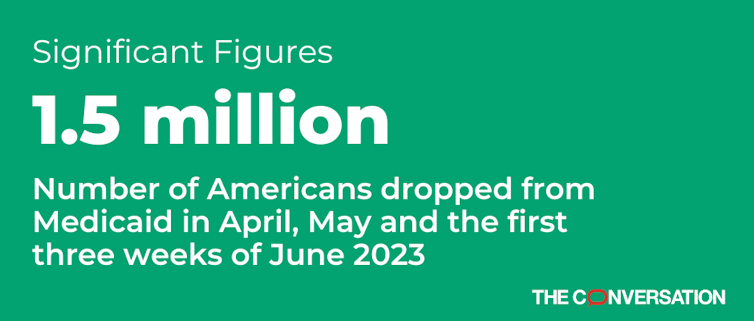

At least 1.5 million Americans lost Medicaid coverage in April, May and the first three weeks of June 2023, according to the Kaiser Family Foundation, a nonprofit that tracks health data.
Because only 25 states had publicly reported this data as of June 22, the actual number of people who lost coverage through Medicaid, the government’s main health insurance program for low-income people and people with certain disabilities, is surely much higher.
This swift decline in Medicaid enrollment follows a huge increase that started in early 2020 and was brought about by temporary policy changes in effect for the first three years of the COVID-19 pandemic. During that time, the federal government didn’t let states, which administer Medicaid, drop anyone from the program – even if their income grew too high to qualify.
As of January 2023, the most recent month for which full data is available, a total of 93 million Americans were insured through either Medicaid or the Children’s Health Insurance Program, known as CHIP, a related program. That marked a 30.7% increase from February 2020.
The federal government has estimated that 15 million people will lose their coverage, including 5.3 million children, by mid-2024 due to the end of the continuous enrollment policy.
Public health emergency over
The sharp spike in Medicaid enrollment stopped abruptly because the U.S. COVID-19 pandemic public health emergency status has expired.
States now must phase out their continuous enrollment policies, but they are doing it on different schedules. Some began in April 2023; others started to send out termination letters in May or June. There are also states that will not begin this process until later in the year or are taking steps to minimize the number of people losing their coverage.
For about 3 in 4 of the people who lost their Medicaid coverage, it was for procedural reasons, such as not filing required paperwork. The remaining 1 in 4 probably became ineligible due to an increase in their income.
Gains from Medicaid
There is mounting evidence that Medicaid has many benefits for society – especially children.
For example, when low-income families remain in the program for long periods of time, they tend to have lower child mortality rates. Medicaid coverage is also associated with kids faring better in school.
Researchers have also determined that the federal government and state governments can get boosts in tax revenue when families obtain this health insurance coverage through Medicaid and CHIP that exceed government spending on these programs. That’s because having better access to health care in the long term is associated with being healthier, staying in school longer and eventually earning a higher income.
The toll that the steep decline in health insurance coverage now underway will take on Americans remains to be seen.
Maithreyi Gopalan has received funding from the Spencer Foundation, American Educational Research Association, Russell Sage Foundation, and the Student Experience Research Network. She is an Impact Fellow (2023-24) at the Federation of American Scientists.
This article was originally published on The Conversation. Read the original article.







